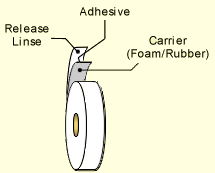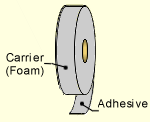Foam Tape Lingo
Foam Tape Lingo
Here we will attempt to explain what all the unusual words used on this website mean...differentially wound, transfer tape...who talks this way? Well, foam tape guys (and gals) do.
Before we get too knee deep in the hoopla, let's go over the various applications that foam tapes are used for and better explain them (believe it or not, as simple as foamtapes seem, they find their way into a LOT of places.
- Gasketing
- Gasketing applications typically involve keeping matter either in or out. This may include liquids (water, oil, etc.), gases or air, solids (like dust) or even light. Most tapes that work for gasketing applications are closed cell or exhibit closed cell properties under compression. The materials that Foamtapes.net sell that work as gasket materials include:
- Weatherstripping
- Weatherstripping applications typically deal with maintaining climate. You want to keep it hot, cold or warm, or you want to maintain a consistent humidity level, etc. These products can be open cell (if you're talking temperature) or closed cell (if talking humidity, or both humidity and temperature). If there is going to be serious moisture involved (like actually keeping rain out) you should look to gasket tapes instead. The materials that Foamtapes.net sell that work as weatherstripping materials include:
Open Cell (for temperature)
Closed cell (for humidity)
- Mounting
- Mounting applications are for, well, for mounting stuff. Like hanging a small sign on a wall, or a graphic on a display, or even trim on appliances, countertops, automobiles, etc. These products are typically closed cell as they need to maintain their strength and don't want to be weakened by the infiltration of water or other liquids. The materials that Foamtapes.net sell that work as mounting tapes include:
- Glazing
- Glazing is a very specific type of mounting where glass is sealed within a door or window unit. Due to the environment involved (sun, rain, hot and cold) the tape must be engineered to withstand all these extremes, while still ensuring that water does not infiltrate and either enter the enclosure or jeopardize the insulating properties of the insulated glass unit. The materials that Foamtapes.net sell that work as glazing tapes include:
- Bumpers
- The urethane bumpers sold on Foamtapes.net can be used for a variety of applications. As shock absorbing feet to protect things from damage due to dropping. As vibration dampers to keep a vibrating motor from transferring it's energy to whatever it's resting on. As non-skid feet to keep a cutting board, computer or other device from sliding on smooth surfaces. Bumpers are used on internally mounted muntin bar (those little metal bars inside your window pane) to keep them from rattling. We even make bumpers designed specifically to protect your wall from your door knob...
Okay, now you know where they go and what they do. Let's talk about how they're made...
Basic Tape Construction
Foam tapes are pretty basic. Don't get me wrong, they're a nifty invention, doing things that a Scotch© tape could never dream of... But once the dishes are done, they're still just some foam with sticky stuff on them.
Here are some typical industry terms you may hear:
- Double Coated
- This terms refers to products that have adhesive coated on both sides of a carrier.
Transfer- In the adhesive industry this refers to an adhesive that has no carrier.
Carrier- This refers to the material (also called a substrate) onto which the adhesive is coated. This may be a film, foil, tissue or foam/sponge.
Unwind side- In a double coated material, this is the adhesive side that is exposed as the roll is unwound. You may also think of this as the side that is wound inward.
Liner side- In a double coated material, this is the adhesive side that is against the release liner. You may also think of this as the side that is wound out.
Release Liner- This is a film or paper (typically coated with a release agent like silicone) that is applied to an adhesive (i.e. the adhesive will not permanently bond to it). It serves to keep the adhesive clean and somewhat dry during storage.
Rubber based- This terms refers to adhesives that are derived from rubber compounds. They typically have the following properties:
- They have a high tack value.
- They have lower shear values.
- They are inert (their bond does not get stronger over time).
- They are not recommended for extended UV exposure.
- They do not perform well on heavily plasticized surfaces.
- They are lower in cost.
- Acrylic based
- This terms refers to adhesives that are derived from acrylic plastics. They typically have the following properties:
- They have a lower tack value.
- They have high shear values.
- Their bond strength tends to increase over the first 72 hours.
- They are recommended in applications with extended UV exposure.
- They perform well on heavily plasticized surfaces.
- They are higher in cost.
- Tack
- This is a physical property, typically measured in pounds per inch of width, that tells how much force is needed to remove the tape once it has been quickly applied to a surface. The most common type of test is a loop tack test, where a 4" long and 1" wide strip is looped, pressed against a stainless steel plate, then the force to remove is measured until the adhesive is completely free.
Shear- This physical property (typically measured in minutes to failure) tests how strong an adhesive is when it is slid across another surface. Typically in this test, an adhesive strip is stuck to an aluminum plate and a small weight is hung from it. The time given is the number of minutes it took the adhesive to slide completely off the plate.
Foam tapes come in two configurations, single coated and double coated.
Single Coated Foam Tapes
As the name might imply, single coated foam tapes only have sticky stuff on one side. These tapes work great for gasketing, shiming, protective packaging, stuff like that. It serves to seal or separate two surfaces without actually bonding them together.
Single coated products come in two varieties, differentially wound or with a release liner. All single coated products from Foamtapes.net have a release liner. Good, I'm glad we got that squared away, but just for your continuing education, we'll present both to you...
Rolls with Release Liner
Since this is what we do, we thought we'd go ahead and be openly biased and present this one first. These types of rolls consist of a foam (called the carrier), an adhesive (the sticky stuff) and a paper or film backing that keeps the sticky stuff from being sticky until you remove it (that's the release liner). The products can be rolled so that the release liner is initially showing, or so that the foam is initially showing. Typically this doesn't matter to anyone, unless you have automated machinery. We wind ours so the release liner is out. Here's a diagram:

Rolls without Release Liner
These are typically referred to as "differentially wound". This is how Scotch™ tape is made. When you peel the tape back, the adhesive is instantly available. No paper to remove. The backside of the carrier (which in our case is a foam) acts as the release liner. Here's a diagram:

When it comes to foam tapes, you will typically only see this type of setup in a product that uses a removable adhesive.
Double Coated Foam Tapes
Double coated foam tapes have an adhesive applied to both sides of the foam/sponge carrier. They are used typically for mounting applications, but serve many purposes. Double coated products (like the single coated) are typically provided in two configurations, differential and with dual release liners. All Foamtapes.net double coated foam products are provided differentially wound (meaning they have only one release liner).
Differentially Wound
These rolls have adhesive on both sides, but only one release liner. When the material is peeled off the roll, one adhesive coating is exposed, while the release liner continues to protect the other side. This is accomplished by using a release liner that has it's release coated on both sides. This is the most common way to receive double coated foam tapes. Here's a diagram:

Rolls with Dual Release Liners
Sometimes you need a release liner on both sides. Maybe your application requires that you cut the foam tape into little pads that are applied later. In these applications, the roll will have two release liners, one on each side. Things to consider when buying or specifying a double release liner product:
- As soon as the product is rolled up, the inside liner will buckle.
- If the foam/sponge is not compression resistant, it will most likely have some permanent wrinkling.
Here's a diagram of a double release liner roll:

Of course, what you do with this information is up to you. We hope you'll use it for good, not evil.

